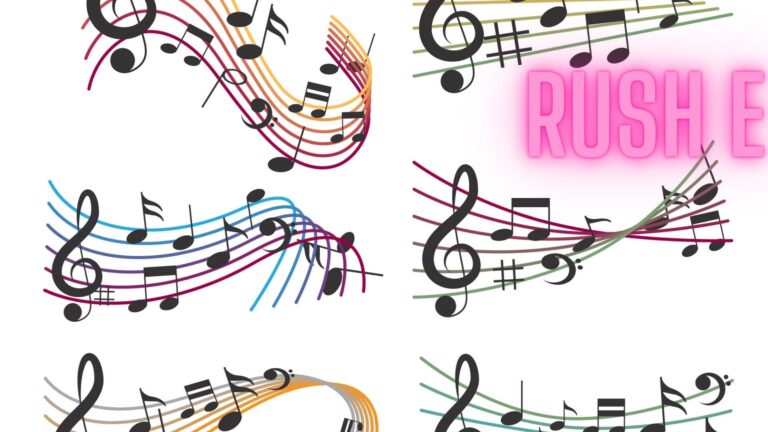In the world of piano music, few pieces are as challenging and exhilarating as “Rush E.” This composition has become a benchmark for pianists who want to test their technical prowess and endurance. Whether you’re an aspiring pianist or a seasoned player, understanding what makes “Rush E” such a significant piece can enhance your appreciation and performance. This article delves into the intricacies of “Rush E,” exploring its history, technical demands, and tips for mastering this demanding piece.
The Origins of Rush E
“Rush E” is a piano piece composed by Sheet Music Boss, a well-known name in the online piano community. Released as part of their repertoire of intricate and impressive arrangements, “Rush E” quickly gained popularity due to its high speed and complex fingerings. The piece is often associated with online piano challenges and has become a popular test among pianists on social media platforms.
The Technical Demands
Speed and Precision
One of the most striking features of “Rush E” is its blistering tempo. The piece requires pianists to maintain an incredibly fast pace while ensuring each note is played accurately. This high-speed execution tests not only finger agility but also hand coordination and overall rhythm.
Complex Fingerings
“Rush E” incorporates rapid finger movements and complex patterns that demand precise finger placement and control. Pianists must navigate through a series of intricate passages that challenge their ability to execute notes cleanly and efficiently.
Hand Coordination
The composition requires excellent hand coordination as pianists must simultaneously manage fast-moving passages in both hands. This dual-hand coordination is crucial for maintaining the piece’s speed and fluidity.
Endurance
Given its length and tempo, “Rush E” is as much a test of endurance as it is of technical skill. Pianists need to develop stamina to perform the piece without compromising their technique or making mistakes.
Tips for Mastering Rush E
Practice Slowly
To master “Rush E,” begin by practicing slowly. Breaking down the piece into manageable sections and playing them at a reduced tempo helps in understanding the fingerings and hand movements. Gradually increase the speed as you become more comfortable with the passages.
Focus on Accuracy
Accuracy is crucial when tackling a piece like “Rush E.” Concentrate on playing each note correctly before attempting to speed up. This approach ensures that you develop a solid foundation and reduce mistakes as you increase the tempo.
Use Proper Technique
Proper technique is essential for performing “Rush’s E” effectively. Pay attention to hand positioning, finger strength, and relaxation. Using correct techniques will help prevent strain and injuries while improving your overall performance.
Build Stamina
Since “Rush’s E” is demanding on endurance, incorporating stamina-building exercises into your practice routine is beneficial. Regularly practicing the piece, along with exercises that enhance finger strength and dexterity, can help build the endurance needed for a successful performance.
Utilize Metronomes and Practice Tools
Metronomes are invaluable tools for maintaining tempo and gradually increasing speed. Use a metronome to help you stay on track and to incrementally build up to the desired tempo of “Rush’s E.”
The Cultural Impact of Rush E
Online Challenges
“Rush’s E” has become a staple in online piano challenges. Many pianists and enthusiasts use it as a test to showcase their skills and compete with others. The piece’s popularity in these challenges has contributed to its widespread recognition and appeal.
Influence on Piano Repertoire
The success of “Rush’s E” has influenced the repertoire of contemporary piano music. It has inspired other composers and arrangers to create similarly challenging pieces, adding to the diversity and complexity of modern piano music.
Community Engagement
The piece has fostered a sense of community among pianists. Online forums, social media groups, and video platforms feature numerous performances and discussions about “Rush’s E,” creating a space for pianists to share their experiences and tips.
Conclusion
“Rush E” stands as a formidable challenge in the realm of piano music. Its demanding tempo, intricate fingerings, and need for exceptional hand coordination make it a true test for pianists of all levels. Mastering this piece requires dedication, practice, and a deep understanding of piano technique. As you work through the complexities of “Rush’s E,” you’ll not only enhance your technical skills but also gain a greater appreciation for the art of piano performance. Whether you’re preparing for a performance or simply exploring new musical challenges, “Rush’s E” offers a rewarding and exhilarating experience for any pianist.
FAQs
What makes “Rush E” so challenging for pianists?
“Rush E” is challenging due to its extremely fast tempo, complex fingerings, and the need for precise hand coordination. The piece demands both technical skill and endurance from pianists.
How can I start practicing “Rush E”?
Begin by practicing slowly to understand the fingerings and hand movements. Gradually increase the tempo as you become more comfortable with the piece. Focus on accuracy and use a metronome to help build speed.
Are there any specific techniques I should use for “Rush E”?
Yes, focus on proper hand positioning, finger strength, and relaxation. Good technique is essential for executing the fast passages and avoiding strain.
How long does it typically take to master “Rush E”?
The time it takes to master “Rush’s E” varies depending on your skill level and practice routine. It may take several weeks or months to achieve a proficient performance.
Why is “Rush E” popular in online piano communities?
“Rush’s E” is popular due to its impressive technical demands and its role in piano challenges. Its complexity and speed make it a favorite among pianists looking to showcase their skills and compete with others online.

